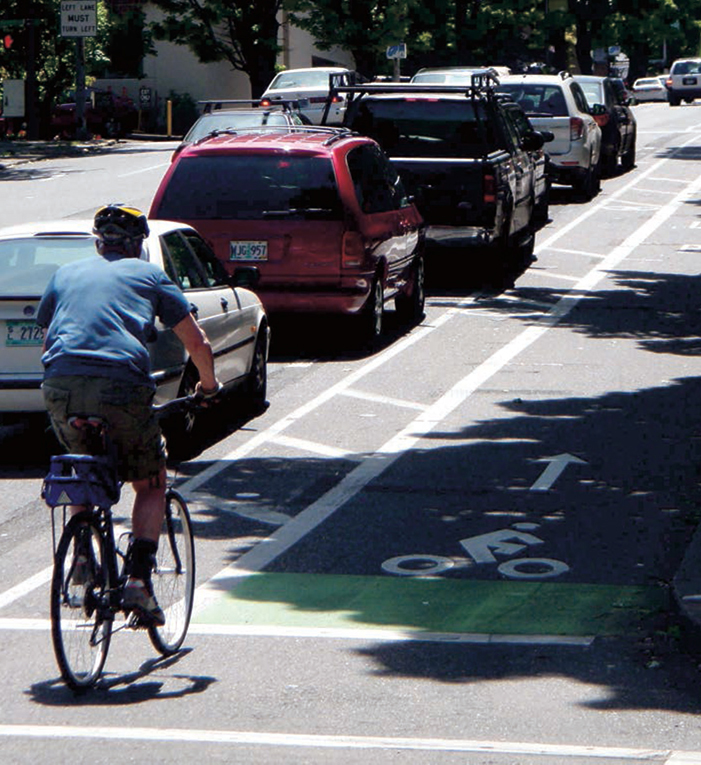
One-Way Protected Cycle Tracks

PORTLAND, OR
One-way protected cycle tracks are bikeways that are at street level and use a variety of methods for physical protection from passing traffic. A one-way protected cycle track may be combined with a parking lane or other barrier between the cycle track and the motor vehicle travel lane. When a cycle track is elevated above street level it is called a raised cycle track and different design considerations may apply.
Compared with bicycling on a reference street* ... these cycle tracks had a 28% lower injury rate.
*“Reference street” refers to a comparable street without dedicated bicycle facilities.
Lusk, A., Furth, P., Morency, P., Miranda-Moreno, L., Willett, W., Dennerlein, J. (2010). Risk of injury for bicycling on cycle tracks versus in the street. Injury Prevention.
Benefits
Dedicates and protects space for bicyclists in order to improve perceived comfort and safety.16
Eliminates risk and fear of collisions with over-taking vehicles.
Reduces risk of ‘dooring’ compared to a bike lane and eliminates the risk of a doored bicyclist being run over by a motor vehicle.17
Prevents double-parking, unlike a bike lane.
Low implementation cost by making use of existing pavement and drainage and by using parking lane as a barrier. More attractive for bicyclists of all levels and ages.18

NEW YORK, NY

LONG BEACH, CA
Typical Applications
Streets with parking lanes.
Streets on which bike lanes would cause many bicyclists to feel stress because of factors such as multiple lanes, high traffic volumes, high speed traffic, high demand for double parking, and high parking turnover. While there are no US standards for the bicyclist and motor vehicle volumes that warrant cycle tracks, several international documents provide basic guidance (see references in the appendix).
Streets for which conflicts at intersections can be effectively mitigated using parking lane setbacks, bicycle markings through the intersection, and other signalized intersection treatments.
Along streets with high bicycle volumes.
Along streets with high motor vehicle volumes and/or speeds.
Special consideration should be given at transit stops to manage bicycle and pedestrian interactions.
ADA/PROWAG Considerations
When providing accessible parking spaces alongside cycle tracks, the following general considerations are recommended to accommodate persons with disabilities in the design of one-way and two-way protected cycle tracks. Local parking regulations and roadway context may vary considerably.
• A widened buffer space may be used to accommodate a side mounted vehicle ramp or lift so that it will not protrude into the cycle track and become a hazard to bicyclists. Additional buffer space may be challenging to achieve with limited right-of-way.
• Mid-block curb ramps may be provided near marked accessible parking spaces, or curb ramps may be provided at a consistent interval along the cycle track to provide additional egress points for wheelchair users to gain access to the sidewalk. Mid-block curb ramps may also offset inconveniences in curbside freight delivery crossing the cycle track.
• Roadway cross-slopes should be considered across the cycle track during design as slopes exceeding two percent will create difficulty for bicyclists and some disabled users.
• If significant Taxi or Paratransit service exists along the cycle track, consider providing periodic loading zones to allow the vehicles to pull out of the travel lane.
• If used, consider placement of bollards in the buffer area so as not to impede access by disabled users. Individuals with sight-impairments may lack familiarity with this roadway configuration. Outreach and education for sight-impaired individuals is advised to ensure that these individuals have a better understanding of changes to the roadway alignment. Select design elements, such as tactile surfaces may help reinforce these measures.
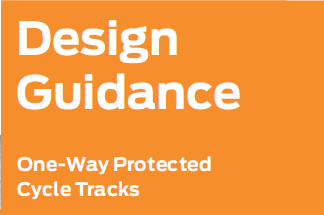

Required Features
 A cycle track, like a bike lane, is a type of preferential lane as defined by the MUTCD.19
A cycle track, like a bike lane, is a type of preferential lane as defined by the MUTCD.19
 Bicycle lane word, symbol, and/ or arrow markings (MUTCD Figure 9C-3) shall be placed at the beginning of a cycle track and at periodic intervals along the facility based on engineering judgment.
Bicycle lane word, symbol, and/ or arrow markings (MUTCD Figure 9C-3) shall be placed at the beginning of a cycle track and at periodic intervals along the facility based on engineering judgment.
 If pavement markings are used to separate motor vehicle parking lanes from the preferential bicycle lane, solid white lane line markings shall be used. Diagonal crosshatch markings may be placed in the neutral area for special emphasis. See MUTCD Section 3B.24. Raised medians or other barriers can also provide physical separation to the cycle track.
If pavement markings are used to separate motor vehicle parking lanes from the preferential bicycle lane, solid white lane line markings shall be used. Diagonal crosshatch markings may be placed in the neutral area for special emphasis. See MUTCD Section 3B.24. Raised medians or other barriers can also provide physical separation to the cycle track.
Recommended Features
 The minimum desired width for a cycle track should be 5 feet. In areas with high bicyclist volumes or uphill sections, the minimum desired width should be 7 feet to allow for bicyclists passing each other.20
The minimum desired width for a cycle track should be 5 feet. In areas with high bicyclist volumes or uphill sections, the minimum desired width should be 7 feet to allow for bicyclists passing each other.20
 Three feet is the desired width for a parking buffer to allow for passenger loading and to prevent door collisions.21
Three feet is the desired width for a parking buffer to allow for passenger loading and to prevent door collisions.21
 When using a parking protected pavement marking buffer, desired parking lane and buffer combined width is 11 feet to discourage motor vehicle encroachment into the cycle track.
When using a parking protected pavement marking buffer, desired parking lane and buffer combined width is 11 feet to discourage motor vehicle encroachment into the cycle track.
 In the absence of a raised median or curb, the minimum desired with of the painted buffer is 3 ft. The buffer space should be used to locate bollards, planters, signs or other forms of physical protection.22
In the absence of a raised median or curb, the minimum desired with of the painted buffer is 3 ft. The buffer space should be used to locate bollards, planters, signs or other forms of physical protection.22
 Driveways and minor street crossings are a unique challenge to cycle track design. A review of existing facilities and design practice has shown that the following guidance may improve safety at crossings of driveways and minor intersections:
Driveways and minor street crossings are a unique challenge to cycle track design. A review of existing facilities and design practice has shown that the following guidance may improve safety at crossings of driveways and minor intersections:
• If the cycle track is parking protected, parking should be prohibited near the intersection to improve visibility. The desirable no-parking area is 30 feet from each side of the crossing.23
• For motor vehicles attempting to cross the cycle track from the side street or driveway, street and sidewalk furnishings and/or other features should accommodate a sight triangle of 20 feet to the cycle track from minor street crossings, and 10 feet from driveway crossing.
• Color, yield lines, and “Yield to Bikes” signage should be used to identify the conflict area and make it clear that the cycle track has priority over entering and exiting traffic.24
• Motor vehicle traffic crossing the cycle track should be constrained or channelized to make turns at sharp angles to reduce travel speed prior to the crossing.
 Gutter seams, drainage inlets, and utility covers should be configured so as not to impede bicycle travel and to facilitate run-off.
Gutter seams, drainage inlets, and utility covers should be configured so as not to impede bicycle travel and to facilitate run-off.
 Sidewalk curbs and furnishings should be used to prevent pedestrian use of the cycle zone.
Sidewalk curbs and furnishings should be used to prevent pedestrian use of the cycle zone.
 Cycle track width should be larger in locations where the gutter seam extends more than 12 inches from the curb.25
Cycle track width should be larger in locations where the gutter seam extends more than 12 inches from the curb.25
Optional Features
 Tubular markers may be used to protect the cycle track from the adjacent travel lane. The color of the tubular markers shall be the same color as the pavement marking they supplement.26
Tubular markers may be used to protect the cycle track from the adjacent travel lane. The color of the tubular markers shall be the same color as the pavement marking they supplement.26
 Cycle tracks may be shifted more closely to the travel lanes on minor intersection approaches to put bicyclists clearly in the field of view of motorists. See Cycle Track Intersection Approach for other methods of transitioning a cycle track to an intersection.27
Cycle tracks may be shifted more closely to the travel lanes on minor intersection approaches to put bicyclists clearly in the field of view of motorists. See Cycle Track Intersection Approach for other methods of transitioning a cycle track to an intersection.27
 A raised median, bus bulb, or curb extension may be configured in the cycle track buffer area to accommodate transit stops. Bicyclists should yield to pedestrians crossing the roadway at these points to reach the transit stop.
A raised median, bus bulb, or curb extension may be configured in the cycle track buffer area to accommodate transit stops. Bicyclists should yield to pedestrians crossing the roadway at these points to reach the transit stop.
 At transit stops, consider wrapping the cycle track behind the transit stop zone to reduce conflicts with transit vehicles and passengers. Bicyclists should yield to pedestrians in these areas. At intersection bus stops, an extended mixing zone may be provided with signage directing bicyclists to yield to buses and loading passengers. Cycle tracks may be configured on the left side of a one-way street to avoid conflicts at transit stops.
At transit stops, consider wrapping the cycle track behind the transit stop zone to reduce conflicts with transit vehicles and passengers. Bicyclists should yield to pedestrians in these areas. At intersection bus stops, an extended mixing zone may be provided with signage directing bicyclists to yield to buses and loading passengers. Cycle tracks may be configured on the left side of a one-way street to avoid conflicts at transit stops.
 A “Bike Lane” sign (MUTCD R3-17) may be used to designate the portion of the street for preferential use by bicyclists. A supplemental “No Cars” selective exclusion sign may be added for further clarification.
A “Bike Lane” sign (MUTCD R3-17) may be used to designate the portion of the street for preferential use by bicyclists. A supplemental “No Cars” selective exclusion sign may be added for further clarification.
 “Bike Only” legend (MUTCD 3D.01) may be used to supplement the preferential lane word or symbol marking.28
“Bike Only” legend (MUTCD 3D.01) may be used to supplement the preferential lane word or symbol marking.28
 Colored pavement may be used to further define the bicycle space.
Colored pavement may be used to further define the bicycle space.
Alternate Protection Strategies
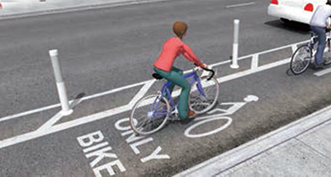
 Tubular Markers
Tubular Markers
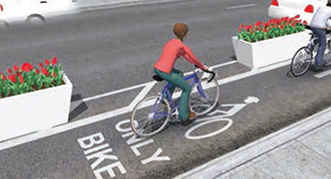
 Movable Planters
Movable Planters
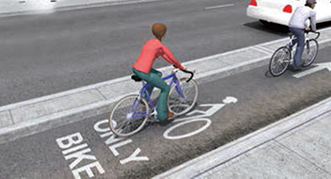
 Raised Curb
Raised Curb
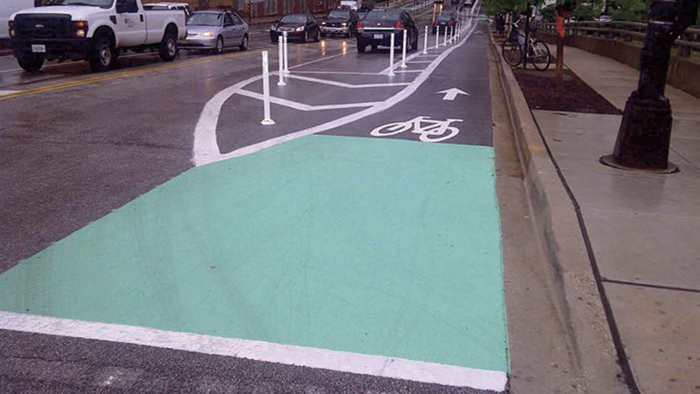
CHICAGO, IL (PHOTO: STEVEN VANCE)
Maintenance
Cycle tracks should be maintained in order to be free of potholes, broken glass and other debris.
Snow removal and street sweeping may require special equipment. This is the case if the combined width of cycle track and buffer, or the cycle track width inside of the raised curb is too narrow for existing street maintenance equipment.
Street sweeping may have to be done more frequently than on streets, especially during the fall, because the lack of the sweeping effect of motor traffic, together with the canyon profile of a cycle track, tends to hold leaves and other debris.
Snow removal may be simplified by putting the cycle track at sidewalk level or by constructing a raised median between the parking lane and the cycle track. Care should be taken to make physically separated cycle tracks accessible by street maintenance equipment, otherwise street sweeping and/or snow removal will need to be done with specialized equipment.
Consider restricting parking at a regularly scheduled time of the week or day to facilitate snow removal and street cleaning.
Bollards or flexible delineators may be removed in winter to provide improved access by snow removal equipment.
If trenching is to be done in the cycle track, the entire facility should be trenched so that there is not an uneven surface or latitudinal joints.
Treatment Adoption and Professional Consensus
Commonly used in dozens of European bicycle friendly cities.
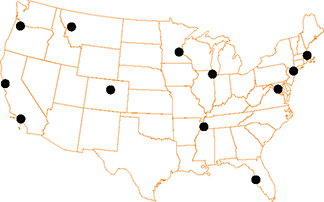
Currently used in the following US cities:
• Boulder, CO
• Cambridge, MA
• Chicago, IL
• Long Beach, CA
• Memphis, TN
• Minneapolis, MN
• Missoula, MT
• New York, NY
• Portland, OR
• San Francisco, CA
• St. Petersburg, FL
• Washington, DC